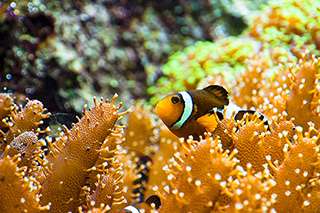Reef fish arrived in two waves

(Phys.org) —The world's reefs are hotbeds of biological diversity, including over 4,500 species of fish. A new study shows that the ancestors of these fish colonized reefs in two distinct waves, before and after the mass extinction event about 66 million years ago that wiped out the dinosaurs.
Reef fish represent one of the largest and most diverse assemblages of vertebrates, according to Samantha Price, a postdoctoral researcher in the Department of Evolution and Ecology at UC Davis. Price is first author on a paper describing the work, published April 2 in the journal Proceedings of the Royal Society B.
The fossil record of reef fish is patchy, so Price and colleagues traced their ancestry by developing a comprehensive family tree of the major group of modern ocean fish, the acanthomorphs or "spiny-finned fish," and calculating the times when different groups migrated into or out of reef habitats.
The first wave of colonization occurred between 70 and 90 million years ago, before the end of the Cretaceous period, they found. At that time, most the world's reefs were built not by coral but by mollusks called rudists.
Rudists disappeared in the mass extinction at the end of the Cretaceous, 66 million years ago, and corals became the world's great reef builders. While the first-wave reef fish hung on to leave descendants in the present, a second wave of colonization took place as the world recovered from the extinction event.
The early wave of colonization began with lots of different-looking fish and over time there was an eventual filling of ecological niches accompanied by a decrease in colonization, Price said.
By about 50 million years ago, the fundamentals of modern coral reefs, including the ancestors of most major families, such as clownfishes and parrotfishes, were in place, Price said.
"If you were able to dive on a coral reef 50 million years ago, the fishes would seem familiar, you would recognize it as similar to a modern reef," she said.
More information: S. A. Price, L. Schmitz, C. E. Oufiero, R. I. Eytan, A. Dornburg, W. L. Smith, M. Friedman, T. J. Near, and P. C. Wainwright. "Two waves of colonization straddling the K–Pg boundary formed the modern reef fish fauna." Proc. R. Soc. B May 22, 2014 281 1783 20140321; DOI: 10.1098/rspb.2014.0321 1471-2954
Journal information: Proceedings of the Royal Society B
Provided by UC Davis




















